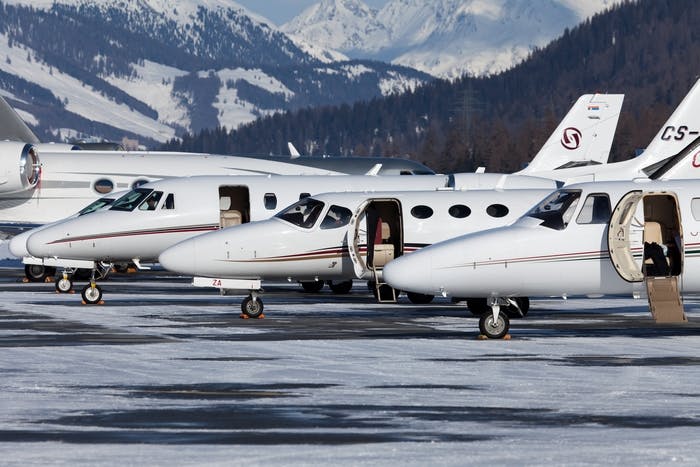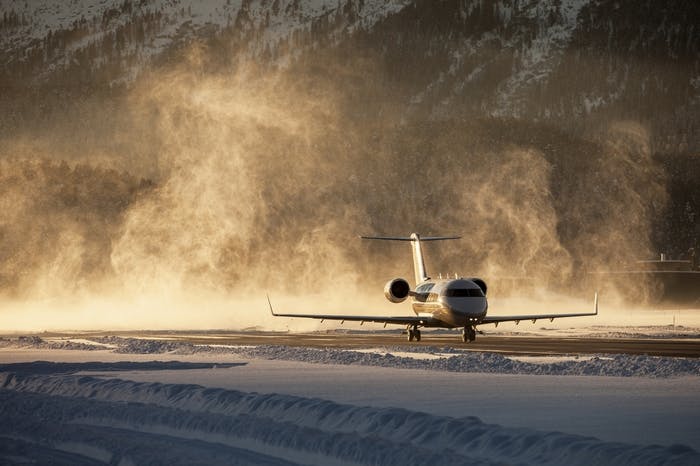De-icing for private jets
Just like a car in winter, a private jet left outside will be exposed to the weather and will become covered in ice and snow.
Unlike a car, it is a legal requirement to remove all ice and snow from a private jet charter aircraft before it takes off.
For more information on de-icing or winter flights call us on 020 7100 6960 (24 hours).
How to de-ice : De-icing costs : Avoiding de-icing costs : FAQs : De-icing Waiver

PrivateFly De-icing Waiver

For your safety, aircraft de-icing is often required during icy and snowy conditions. This is a legal requirement prior to takeoff. In severe winter weather, multiple de-icings may be required.
As it cannot be predicted if and how much de-icing fluid is required prior to a flight, for an on-demand private jet charter the client is liable after the flight for the cost of any ground de-icing required. This is industry standard practice and set out in PrivateFly's Standard Charter Terms. De-icing charges are usually invoiced at cost price after the flight is completed.
For our PrivateFly Jet Card clients, de-icing costs are included in the fixed hourly rates, so there are no additional fees to pay if and when de-icing is required. Find out more about the PrivateFly Jet Card.
For on-demand charter clients, during winter operations, PrivateFly offers a De-Icing Waiver as protection against these potential charges. This is similar to a collision damage waiver for hire cars.
De-Icing Summary
- For on-demand flights, the only extra cost not included in your PrivateFly contract is ground de-icing charges (invoiced to you at cost).
- Actual de-icing costs vary depending on the amount of fluid required. The average de-icing cost for a small jet is 1,000 EUR per application. De-icing larger aircraft can cost over 10,000 EUR.
- The PrivateFly De-Icing Waiver is calculated according to the risk of de-icing and is based on a percentage of the predicted cost. For example, on a small jet the waiver is often just 150 EUR per flight.
- PrivateFly Jet Card clients do not pay additional de-icing costs.
If no De-Icing Waiver is purchased, we require a deferred credit card charge of a minimum 1500 EUR, prior to the flight. If de-icing is then required, we will contact you to arrange payment of the cost price (which may differ from the deferred payment). The deferred payment will be cancelled if no de-icing is required.
To book or for further information on a De-icing Waiver for private flights call 020 7100 6960 (24 hours).
How is a private jet de-iced?
Just like de-icing a car window screen, de-icing fluid is sprayed onto a private jet. This fluid has either (or both) de-icing or anti-icing properties.
At an airport, de-icing fluid is sprayed onto the private jet by a specially designed vehicle called a de-icing rig. Often a first time private jet customer can be alarmed at the amount of fluid sprayed onto the airframe, it is similar to a fireman's hose!
The de-icing fluid is often applied at a high temperature and is normally orange in colour. This helps to indicate where the fluid has been applied.
Private jet customers are often asked to be on-board during the de-icing process. This allows a quick take off after de-icing.

How much does it cost to de-ice a private jet
De-icing fluid is expensive. Each airport will have a cost per litre for de-icing fluid and often there is only one supplier a private jet can use. The average amount of de-icing fluid and cost for a private jet are:
| Type | Fluid Quantity | Price per Litre | Total Cost |
|---|---|---|---|
| Small Propeller | 50 | €5 | €250 |
| Small Jet | 200 | €5 | €1000 |
| Medium Jet | 300 | €5 | €1500 |
| Long Range Jet | 500 | €5 | €2500 |
| Regional Airliner | 700 | €5 | €3500 |
| Airliner | 2000 | €5 | €10000 |
If you buy the PrivateFly De-icing Waiver, then you don't have to worry about the cost of de-icing the private jet. For full details contact us or call us on 020 7100 6960.
Who pays when a private jet is de-iced?
For an on-demand private jet charter, the charterer of the private jet (the client) is liable for the cost of de-icing a private jet. The cost of de-icing is not included in the price to hire a private jet. If de-icing is required, this will be invoiced at cost price after the flight. The cost of de-icing a private jet can be reduced by buying a De-icing Waiver.
How to avoid paying de-icing costs
Private jet pilots can avoid de-icing by arranging for their aircraft to be kept in a hangar. However at some airports the cost of overnight hangarage can be more expensive than de-icing. Many private jet airports do not have hangar space available and so the aircraft will be exposed to the weather prior to your private jet flight.
A private jet can also be de-iced by using a heated hangar for a shorter period of time before departure. This less expensive option can reduce the cost of de-icing required or prevent it being required. Often placing an aircraft that requires de-icing in a heated hangar for 1 hour, will melt the ice on the airframe completely.
At some private jet airports, passengers can board their private jet inside the hangar before it is towed outside. In winter periods this is a favourite customer service tip used by PrivateFly for our members.
The only way to guarantee you can avoid de-icing costs is to take out a De-icing Waiver.
Top 10 Tips for de-icing a private jet

Ask your private jet supplier the night before your flight if de-icing is expected to be required. This will encourage them to avoid de-icing if possible. See how to avoid paying de-icing costs.
Use a hangar to keep your private jet protected from the weather. A heated hangar can also be used to melt any ice that has formed.
Encourage your crew to remove layers of snow with a brush from the wings before the aircraft is de-iced. This will reduce the amount of de-icing fluid required. This manual procedure is only possible on small aircraft. On large private jets it is not safe to remove snow from the wings.
Keep your private jet crew informed of when you will be arriving at the FBO (private jet terminal) This will allow the de-icing to be timed just before your arrival and prevent it being required twice
Ask to be on-board your private jet when it is de-iced. This will allow your aircraft to depart immediately after the anti-icing fluid is applied. A further de-ice may be required if your departure is delayed.
Never argue against a de-ice. Your private jet Captain is making a safety decision and should not be influenced by financial or time considerations.
Ask your crew how much de-icing fluid is expected to be used before the de-ice starts. This will encourage the crew to remove excess snow from the airframe with a brush to reduce the amount of fluid required. In larger aircraft this will not be possible.
If you have a choice of airports, ask for the price of de-icing fluid at each FBO (Private Jet Terminal). Depart from the private jet airport that offers the lowest price of de-icing fluid. Often the de-ice is more expensive than the landing and handling fees.
If possible avoid flying very early in the morning. Often the sun will melt any thin layers of ice on a private aircraft.
Buy a De-icing Waiver from PrivateFly before your private jet flight call us on 020 7100 6960 or contact us.

Private Jet de-icing - FAQs
Why must a private jet be de-iced?
It is a legal requirement for all ice and snow to be removed from an aircraft before it departs from an airport.
- Snow and ice on a wing reduce its lift performance. Even the thinnest layer of frost affects how an aircraft flies.
- Snow and ice are heavy. The extra weight of snow and ice on a private jet will reduce its flight performance.
- The controls of a private jet (ailerons, elevators and rudders) can be blocked by ice and full movement may not be possible
What is the fluid used to de-ice a private jet?
A private jet is sprayed with a heated fluid that has two purposes:
- To de-ice, melt and remove existing snow and ice from the airframe.
- To form a protective layer that stops new ice forming, for a period known as the 'hold over time'.
Do all airports have de-icing fluid available?
In particularly cold winters, de-icing fluid can be limited at some airports. Some smaller airfields may not have de-icing fluids. At larger airports, and especially at peak airline departure times, there may be a long delay before your aircraft is de-iced.
Which countries are excellent at de-icing private jets?
German and Scandinavian airports are experts in de-icing procedures for private jets.
What does de-icing fluid smell like?
A private jet passenger should never come into contact with de-icing fluid. It is a dangerous chemical that can cause skin irritations and other medical problems. It does however smell of almonds!
For more information on de-icing or winter flights call us on 020 7100 6960 (24 hours).


